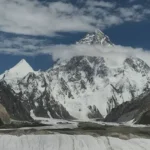About Gilgit-Baltistan
Gilgit-Baltistan (GB) is a very sparsely populated high-mountain area in the north of Pakistan. Its natural environment is usually described with superlatives – the longest glaciers outside of the polar region, home of the world’s second highest peak (K2) and four more eight-thousanders. GB is largely a high-mountain desert; geologically, it spreads over three high mountain systems: Himalaya, Karakorum and Hindukush. The society of GB is diverse in terms of language, religion and ethnicity.
Gilgit-Baltistan of Pakistan is endowed with some of the unique geographical features of the world. In an area of about 500 km wide and 350 km deep, is found to be the most lucrative collection of some of the highest peaks in the world. It has over 700 peaks above 6000 meters, and more than 108 peaks above 7000 meters including five of the highest peaks in the world. The world second highest peak, a rock pyramid K-2 (8611)m, the killer mountain Nanga Parbat (8126 m), the Hidden Peak of Gasherbrum I (8068m), the Broad Peak (8057m) and the Gasherbrum II (8035m) can be found in the region. These enormous mountain peaks make Gilgit-Baltistan a prominent adventure tourist destination offering massive mountaineering opportunities and adventures. The area is known to be a paradise for mountaineers, adventure seekers and nature lovers. The compelling charm of these magnificent and challenging peaks attracts tourists from around the globe.
Importance of Gilgit-Baltistan
Gilgit-Baltistan spans 27,188 square miles (72,000 square kilometers) with a population of around 2.3 million. It consists of three divisions - Gilgit, Baltistan, and Diamer - further divided into ten districts.
The region is bordered by the Wakhan strip (Afghanistan) and Xinjiang (China) to the north, Indian-occupied Kashmir to the south and southeast, and Chitral (KPK) to the west. It features tall, snow-covered mountains and many valleys. The Hindukush range to the north separates Ishkuman and Yasin valleys from the Wakhan corridor. The Pamirs join the Hindukush near the Pakistan, China, and Afghanistan borders. Further east are the Karakoram's Muztagh mountains, with the Gilgit, Indus, and Shyok rivers forming its southern boundary, separating it from the Himalayas. K2, at 28,251 feet, is the highest peak, followed by Gasherbrums, Broad Peak, Rakaposhi, and Mashabrum. In the eastern Himalayas, Nanga Parbat is the highest at 26,620 feet. Pakistan (Gilgit Baltistan) has five of the world's fourteen mountains taller than 8,000 meters (26,000 feet), with four near Concordia in the Baltoro region.
The people of Gilgit-Baltistan share close religious, ethnic, and linguistic ties with those in Kargil (occupied Kashmir). The majority are Muslims of Balti origin, speaking Balti in Kargil and Shina in Dras. In the 1948 liberation war, Kargil and Dras were initially captured but later reoccupied by the Indian army. Currently, the Pakistan Army has strategic superiority in Kargil, threatening India's communication line to Siachen. The Deosai Plain, 30 kilometers from Skardu, is the world's second-highest plateau, covering 3,000 square kilometers at an average elevation of 3,500 meters, and is mostly snow-covered.
Gilgit Baltistan boasts diverse attractions, including mountains, the Deosai plateau, lakes, the Karakoram Highway, glaciers, deserts, forests, flora, fauna, heritage, culture, and traditions. In 2017, over 1.72 million tourists visited, with an expected 2.5 million this year. Properly organized tourism could be a significant revenue source. Historically, the people of Gilgit-Baltistan are notable warriors, evident from battles against Dogras, the British, and the Indian army. On October 31, 1947, the Gilgit Scouts staged a coup in favor of Pakistan, leading to the Dogra governor's surrender and the raising of Pakistan’s flag. The Scouts later became the Northern Light Infantry (NLI), excelling notably during the Kargil War and other conflicts. The people of Gilgit Baltistan are patriotic Pakistanis who, after their liberation, sought integration with Pakistan. Despite some government packages, expectations of people of the region remain unmet. Therefore, the people of Gilgit-Baltistan seek a provincial status or an empowered government like Kashmir till the final settlement of the Kashmir issue.

Nanga Parbat -Himalayas
The ninth-highest mountain globally, infamous for its challenging ascent.

Gasherbrum II
The 13th highest mountain globally, providing breathtaking views of the Baltoro region.

Gasherbrum I-Karakoram Range
Known for its stunning beauty and relatively low number of ascents.



